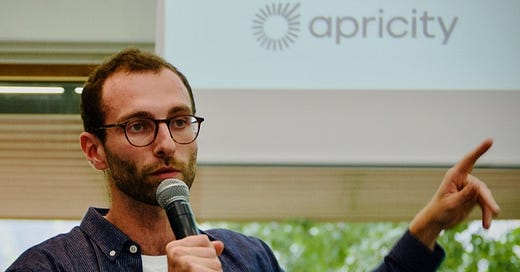Enhancing Fertility Treatment Success with AI: A Conversation with Jérôme Chambost - Apricity
💡 muffin.ai: the media to understand the challenges of AI and leverage them in our society and jobs — by a collective of French engineers & entrepreneurs.
Hello everyone!
We are excited to publish a new deep dive into the fascinating world of artificial intelligence with visionaries. 🙌
Your voice matters a great deal to us. Share your thoughts, questions, and suggestions with us. 🙏
Today we are sharing our conversation with Jérôme Chambost, CTO at Apricity.
Apricity supports patients undergoing fertility treatments (mainly in vitro fertilization) from diagnosis to the birth of the baby.
🧁 We loved gaining a better understanding of how fertility treatments work and the benefits of artificial intelligence data models in increasing their success.
Jérôme simply explains the challenges of the sector 👏.
On the menu today:
🧪 What are fertility treatments?
💡 The benefits of artificial intelligence in improving these treatments
⚙️ The challenges of the sector
👀 Where to find information - sources recommended by Jérôme
If anyone shared this newsletter and you’re willing to subscribe, it’s here:
🧁 MF : Hello Jérôme, before we delve into artificial intelligence and its impact on fertility treatments, could you tell us more about this field that is still too unknown to the general public?
👉 Jérôme :
It is estimated that one in six heterosexual couples has fertility issues and needs to resort to fertility treatments. In addition to this, there are requests from single women and homosexual couples! By 2100, 300 million people will owe their lives to in vitro fertilization. It’s a heavy and stressful procedure with still low success rates: 30% success per attempt and on average, 3 treatments are needed for success. Improving the success of treatments remains a major challenge, and I am convinced that AI has a significant role to play at several stages of the process!
For context, a fertility treatment is a complex equation aiming to enable a patient to become pregnant while minimizing health risks and discomfort. There are three key steps for this:
Step 1: Ovarian stimulation - a woman’s ovaries are stimulated with hormones to produce multiple mature eggs instead of one during a natural cycle.
Step 2: Ovarian puncture and oocyte fertilization - the doctor extracts the mature eggs with a needle; these eggs are then mixed with sperm in the laboratory.
Step 3: Embryonic development and embryo transfer - the fertilized eggs develop in vitro. After a few days, the embryos deemed of the highest quality by a biologist are selected and transferred into the patient’s uterus.
At Apricity, we tailor fertility journeys to the specific needs of patients, their preferences, and their location, so they can access care in the way that suits them best, enhancing their experience and maximizing their chances of success.
🧁 MF : How can artificial intelligence contribute to improving the success rates of fertility treatments?
👉 Jérôme:
AI can assist the doctor at every stage of the treatment:
Before the treatment and from diagnostic data: we aim to predict the probability of success of a fertility treatment based on the specific treatment.
During ovarian stimulation, algorithms strive to adapt the treatment and hormone dosages to the patient's profile, to maximize the number of mature oocytes at the end of the treatment.
During embryonic development, algorithms assist the biologist (embryologist) in selecting the embryos with the highest viability potential by detecting morphological and kinetic characteristics - the possibilities are numerous: training young embryologists in parameter detection, replicating the selection pattern of an embryologist, standardizing choices from a multitude of embryologists, detecting genetic anomalies, predicting viability.
🧁 MF : What are the challenges in the field?
👉 Jérôme:
We are confronted with low volumes of data and poor data quality. Indeed, a large assisted reproduction medical center sees about 2000 patients per year. Even with 10 years of history, it’s not much for AI algorithms. We need to aggregate isolated data from several hospitals to have sufficient cohorts, requiring significant effort to respect patients' rights on the collection of sensitive data and to standardize heterogeneous databases.
Specifically, to detect a morphological parameter on a 5-day embryo or to reproduce a “basic” classification of the embryologist, we become efficient starting from a few thousand images. To determine viability based on more parameters (images of embryos on day 1, day 2, day 3, and day 5, and the morphokinetic development parameters, or even the embryo’s development video), the order of magnitude is rather around a million. As for the stimulation algorithms, we can predict with good accuracy the number of oocytes collected at the end of a treatment from tens of thousands of treatment cycles following the same protocol.
🧁 MF : Thank you, Jérôme! Can you leave us with the sources you recommend for delving deeper into this topic?
👉 Jérôme:
We are at the crossroads between AI and medicine:
Human Reproduction, ESHRE (European Society of Human Reproduction and Embryology), and Fertility and Sterility.
Our latest scientific publication in Oxford Academic here.
Our latest scientific publication in MICCAI here.
Enjoy your week !
— muffin.ai team
If you enjoyed the edition, consider clicking on the ❤️ button and leaving a comment so that more people can discover muffin.ai on Substack 🙏







